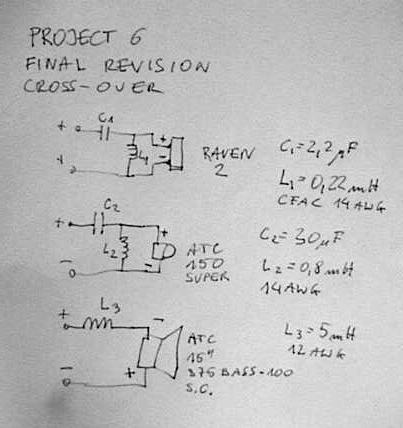
Please note that this is my first fully RESISTORLESS crossover. I am very proud of it.
Some notes:
L3= as thick as possible and AIR type only. I use 1,8
mm motor wire.
C2 is in my case Hovland, but any good polypropylene cap
for 100 V DC will do here, like North Creek Crescendo for example.
L2 is a motor wire 1 mm air coil and any good quality
coil will do here. Medium importance of quality.
L1 - quality quite unimportant. I use 14 AWG Goertz foil
air core inductor.
C1 is most critical. Nothing less than Hovland will do.
Actually North Creek is quite near. Audio Note Copper PIO would be just
perfect !!!
How it was done:
What are the crossover points? Are you trying to understand the circuit ?
Well, it is not so easy to explain. First, my method does
not apply to every construction.
You must first choose a FIRST CLASS midrange that deserves
to be used. I know maybe 10 such units. There must be more out there.
1. I started with playing the midrange wide open straight
from the amp.
The sound was really fabulous. Of course I used vocal
material without any bass contents.
I must be first of all VERY HAPPY about the character
of female vocals.
If it is bad, any other work is a waste of time and XO
will not help it.
2. I protected the bottom end of the mid by applying various
caps until it
could play clean a 100 W material. It was a 12 uF cap
in series. The sound was OK, but midrange impact
transients were a little distorted (the mid has a 80
Ohm resonance at 300 Hz).
3. So in went the resonance trap - the RLC tuned for 300
Hz. Then I removed the C from that RLC
as it was unnecessary. Then off went the R. Just the
coil is enough. So we are back to simple 2nd order hipass.
The remaining L is what you see.
No lopass at all!
The cap in second order XO was increased to 30 uF.
4. Then I left the top end of the ATC wide open and matched
the tweeter to it:
1 uF cap was good. Sounds great. Everything AFTER listening
was carefully controlled by at least three
methods of measurements and testing.
5. I filtered the bass to gently fill in the bottom. That
is easy: Just play
with the L first order until it matches. Crossover point
(break even) is about 500 Hz. The bass driver
plays absolutely clean until 1,5 k (!)
6. Listening to 50 albums
7. Again, VERY loud material reveals that the Raven is
sweating a little at say
4 K. So I increased filtering by adding a very small
coil in parallel. Increase cap to compensate
to 2,2 uF.
XO is now around 6k.
8. EVERYTHING is perfect. Clean clean clean, very open
and free sound, filling
the entire room. No hardness up to 100 W of power.
What is most important, each driver is happy doing what
is doing. It is not
forced to do what it cant do well, even if ON PAPER it
should.
9. Keep it like that and forget.
Computers were useless this time. Book formulas were useless.
Just understand R, L and C
impedance and Ohms law, and tune tune tune.
Ah! And you can admire the final XO in action:
|
|